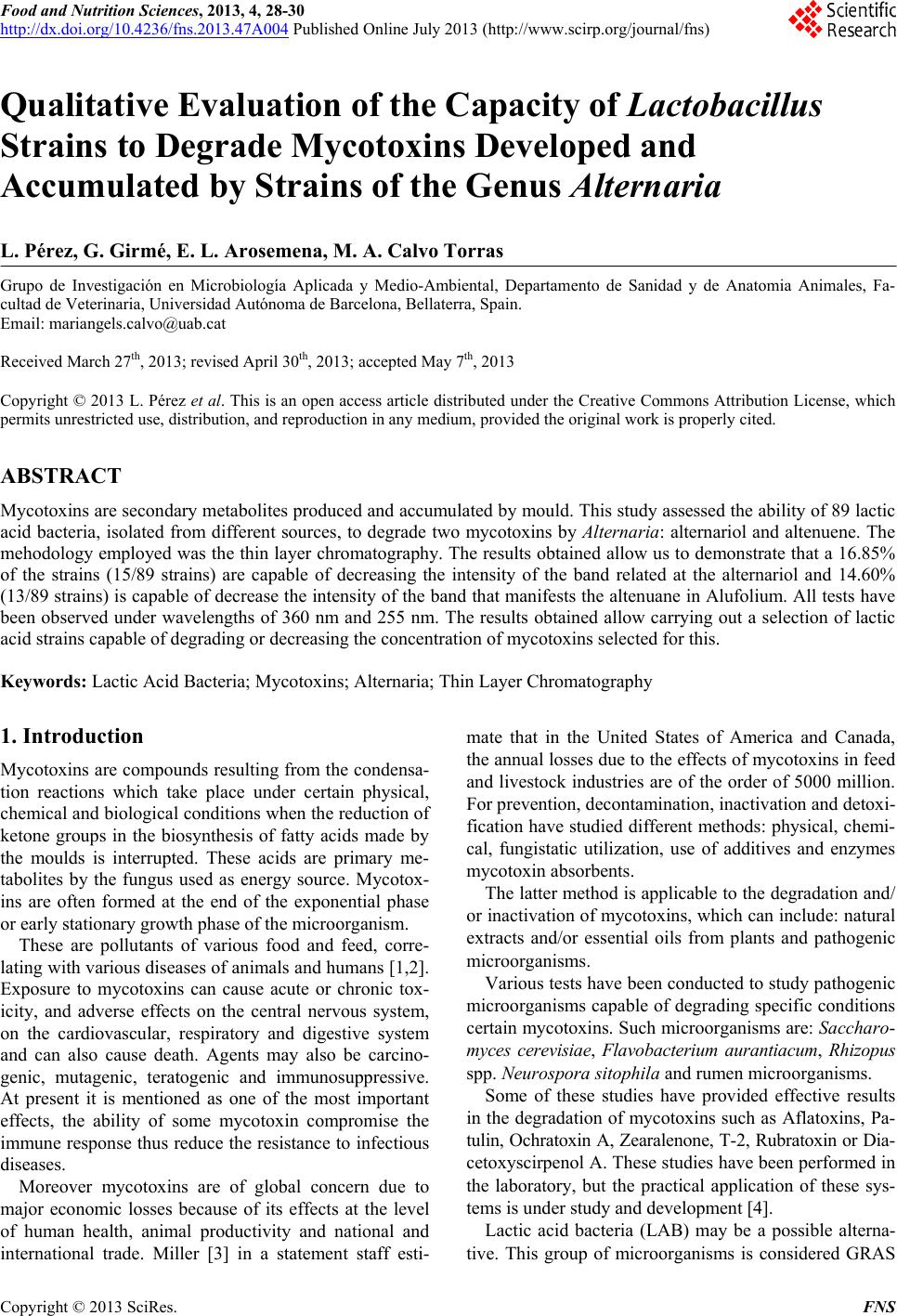
Food and Nutrition Sciences, 2013, 4, 28-30
http://dx.doi.org/10.4236/fns.2013.47A004 Published Online July 2013 (http://www.scirp.org/journal/fns)
Qualitative Evaluation of the Capacity of Lactobacillus
Strains to Degrade Mycotoxins Developed and
Accumulated by Strains of the Genus Alternaria
L. Pérez, G. Girmé, E. L. Arosemena, M. A. Calvo Torras
Grupo de Investigación en Microbiología Aplicada y Medio-Ambiental, Departamento de Sanidad y de Anatomia Animales, Fa-
cultad de Veterinaria, Universidad Autónoma de Barcelona, Bellaterra, Spain.
Email: mariangels.calvo@uab.cat
Received March 27th, 2013; revised April 30th, 2013; accepted May 7th, 2013
Copyright © 2013 L. Pérez et al. This is an open access article distributed under the Creative Commons Attribution License, which
permits unrestricted use, distribution, and reproduction in any medium, provided the original work is properly cited.
ABSTRACT
Mycotoxins are secondary metabolites produced and accumulated by mould. This study assessed the ability of 89 lactic
acid bacteria, isolated from different sources, to degrade two mycotoxins by Alternaria: alternariol and altenuene. The
mehodology employed was the thin layer chromatography. The results obtained allow us to demonstrate that a 16.85%
of the strains (15/89 strains) are capable of decreasing the intensity of the band related at the alternariol and 14.60%
(13/89 strains) is capable of decrease the intensity of the band that manifests the altenuane in Alufolium. All tests have
been observed under wavelengths of 360 nm and 255 nm. The results obtained allow carrying out a selection of lactic
acid strains capable of degrading or decreasing the concentration of mycotoxins selected for this.
Keywords: Lactic Acid Bacteria; Mycotoxins; Alternaria; Thin Layer Chromatography
1. Introduction
Mycotoxins are compounds resulting from the condensa-
tion reactions which take place under certain physical,
chemical and biological conditions when the reduction of
ketone groups in the biosynthesis of fatty acids made by
the moulds is interrupted. These acids are primary me-
tabolites by the fungus used as energy source. Mycotox-
ins are often formed at the end of the exponential phase
or early stationary growth phase of the microorganism.
These are pollutants of various food and feed, corre-
lating with various diseases of animals and humans [1,2].
Exposure to mycotoxins can cause acute or chronic tox-
icity, and adverse effects on the central nervous system,
on the cardiovascular, respiratory and digestive system
and can also cause death. Agents may also be carcino-
genic, mutagenic, teratogenic and immunosuppressive.
At present it is mentioned as one of the most important
effects, the ability of some mycotoxin compromise the
immune response thus reduce the resistance to infectious
diseases.
Moreover mycotoxins are of global concern due to
major economic losses because of its effects at the level
of human health, animal productivity and national and
international trade. Miller [3] in a statement staff esti-
mate that in the United States of America and Canada,
the annual losses due to the effects of mycotoxins in feed
and livestock industries are of the order of 5000 million.
For prevention, decontamination, inactivation and detoxi-
fication have studied different methods: physical, chemi-
cal, fungistatic utilization, use of additives and enzymes
mycotoxin absorbents.
The latter method is applicable to the degradation and/
or inactivation of mycotoxins, which can include: natural
extracts and/or essential oils from plants and pathogenic
microorganisms.
Various tests have been conducted to study pathogenic
microorganisms capable of degrading specific conditions
certain mycotoxins. Such microorganisms are: Saccharo-
myces cerevisiae, Flavobacterium aurantiacum, Rhizopus
spp. Neurospora sitophila and rumen microorganisms.
Some of these studies have provided effective results
in the degradation of mycotoxins such as Aflatoxins, Pa-
tulin, Ochratoxin A, Zearalenone, T-2, Rubratoxin or Dia-
cetoxyscirpenol A. These studies have been performed in
the laboratory, but the practical application of these sys-
tems is under study and development [4].
Lactic acid bacteria (LAB) may be a possible alterna-
tive. This group of microorganisms is considered GRAS
Copyright © 2013 SciRes. FNS